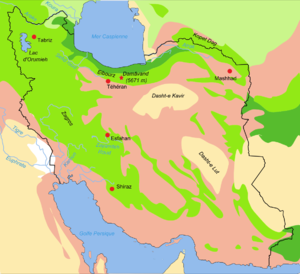Dasht-e Lut

The Lut Desert, widely referred to as Dasht-e Lut (Persian: دشت لوت, "Emptiness Plain"), is a large salt desert located in the provinces of Kerman and Sistan and Baluchestan, Iran. It is the world's 27th-largest desert, and was inscribed on UNESCO's World Heritage List on July 17, 2016.[1] The surface of its sand has been measured at temperatures as high as 70 °C (159 °F),[2][3] making it one of the world's driest and hottest places.
Description

Iran is climatically part of the Afro-Asian belt of deserts, which stretches from the Cape Verde islands off West Africa all the way to Mongolia near Beijing, China. The patchy, elongated, light-colored feature in the foreground (parallel to the mountain range) is the northernmost of the Dasht dry lakes that stretch southward 300 kilometers (190 mi). In near-tropical deserts, elevated areas capture most precipitation. As a result, the desert is largely an abiotic zone[further explanation needed].
Iran's geography consists of a plateau surrounded by mountains and divided into drainage basins. Dasht-e Loot is one of the largest of these desert basins, 480 kilometers (300 mi) long and 320 kilometers (200 mi) wide,[4] and is considered to be one of the driest places on Earth.[5][6][7]
The area of the desert is about 51,800 square kilometres (20,000 sq mi).[8] The other large basin is the Dasht-e Kavir. During the spring wet season, water briefly flows down from the Kerman mountains, but it soon dries up, leaving behind only rocks, sand, and salt.
The eastern part of Dasht-e Loot is a low plateau covered with salt flats. In contrast, the center has been sculpted by the wind into a series of parallel ridges and furrows, extending over 150 km (93 mi) and reaching 75 metres (246 ft) in height.[4] This area is also riddled with ravines and sinkholes. The southeast is a vast expanse of sand, like a Saharan erg, with dunes 300 metres (980 ft) high, among the tallest in the world.[4]
Hottest land surface
Measurements of MODIS (Moderate-Resolution Imaging Spectroradiometer) installed on NASA's Aqua satellite from 2003 to 2010 testify that the hottest land surface on Earth is located in Dasht-e Lut and land surface temperatures reach here 70.7 °C (159.3 °F), though the air temperature is cooler.[5][6][7][9][10][11] The precision of measurements is 0.5 K to 1 K.[12][13]
The hottest part of Dasht-e Lut is Gandom Beryan, a large plateau covered in dark lava, approximately 480 square kilometres (190 sq mi) in area.[14] According to a local legend, the name (in translation from Persian — "Toasted wheat") originates from an accident where a load of wheat was left in the desert which was then scorched by the heat in a few days.
See also
Further reading
- Sykes, Percy. A History of Persia. Macmillan and Company: London (1921). pp. 60–62.
References
- ^ "Lut Desert". UNESCO World Heritage Centre. United Nations Educational, Scientific and Cultural Organization. Retrieved 17 July 2016.
- ^ Mildrexler, D.; M. Zhao; S. W. Running (October 2006). "Where Are the Hottest Spots on Earth?". EOS. 87 (43): 461, 467. doi:10.1002/eost.v87.43.
- ^ Mildrexler, D.; M. Zhao; S. W. Running (2011). "Satellite Finds Highest Land Skin Temperatures on Earth". Bull. Amer. Meteor. Soc. 92: 850–860. doi:10.1175/2011BAMS3067.1.
- ^ a b c editors, Richard L. Scheffel, Susan J. Wernert ; writers, Oliver E. Allen ...; et al. (1980). Natural Wonders of the World. The Reader's Digest Association, Inc. p. 117. ISBN 978-0-89577-087-5.
{{cite book}}:|author=has generic name (help)CS1 maint: multiple names: authors list (link) - ^ a b Satellites seek global hot spots / The Christian Science Monitor - CSMonitor.com
- ^ a b Temperature of Earth
- ^ a b Images of the Day - Images - redOrbit
- ^ Wright, John W. (ed.) (2006). The New York Times Almanac (2007 ed.). New York, New York: Penguin Books. p. 456. ISBN 978-0-14-303820-7.
{{cite book}}:|first=has generic name (help) - ^ The Hottest Spot on Earth : Image of the Day
- ^ Weather Iran Template:Fa icon
- ^ PressTV Iran Archived September 28, 2012, at the Wayback Machine
- ^ MOD 11 - Land Surface Temperature and Emissivity, MODIS Website
- ^ Zhengming Wan (April 1999) MODIS Land-Surface Temperature Algorithm Theoretical Basis Document (LST ATBD) Version 3.3
- ^ A Journey To Earth's Hottest Point


